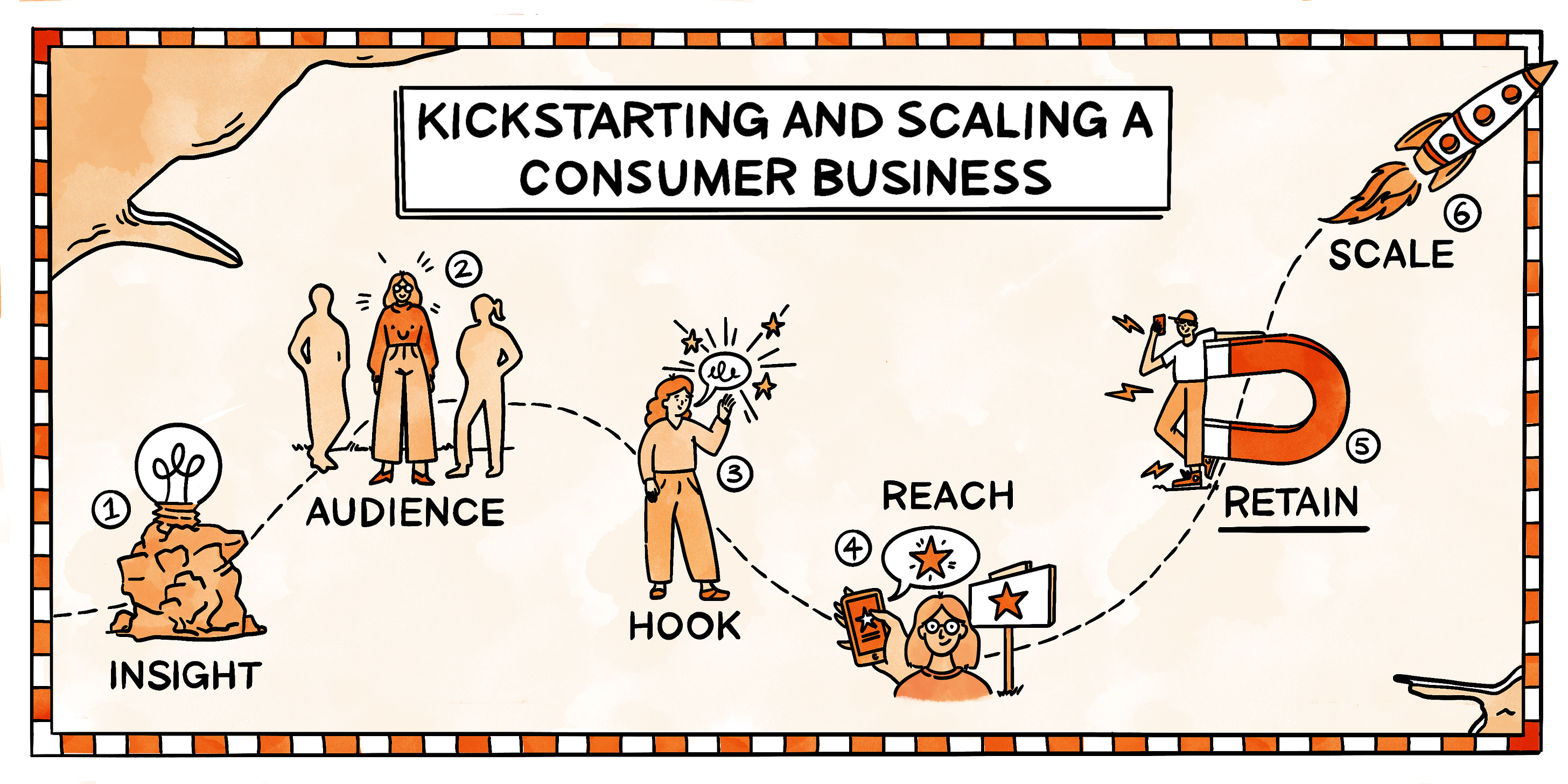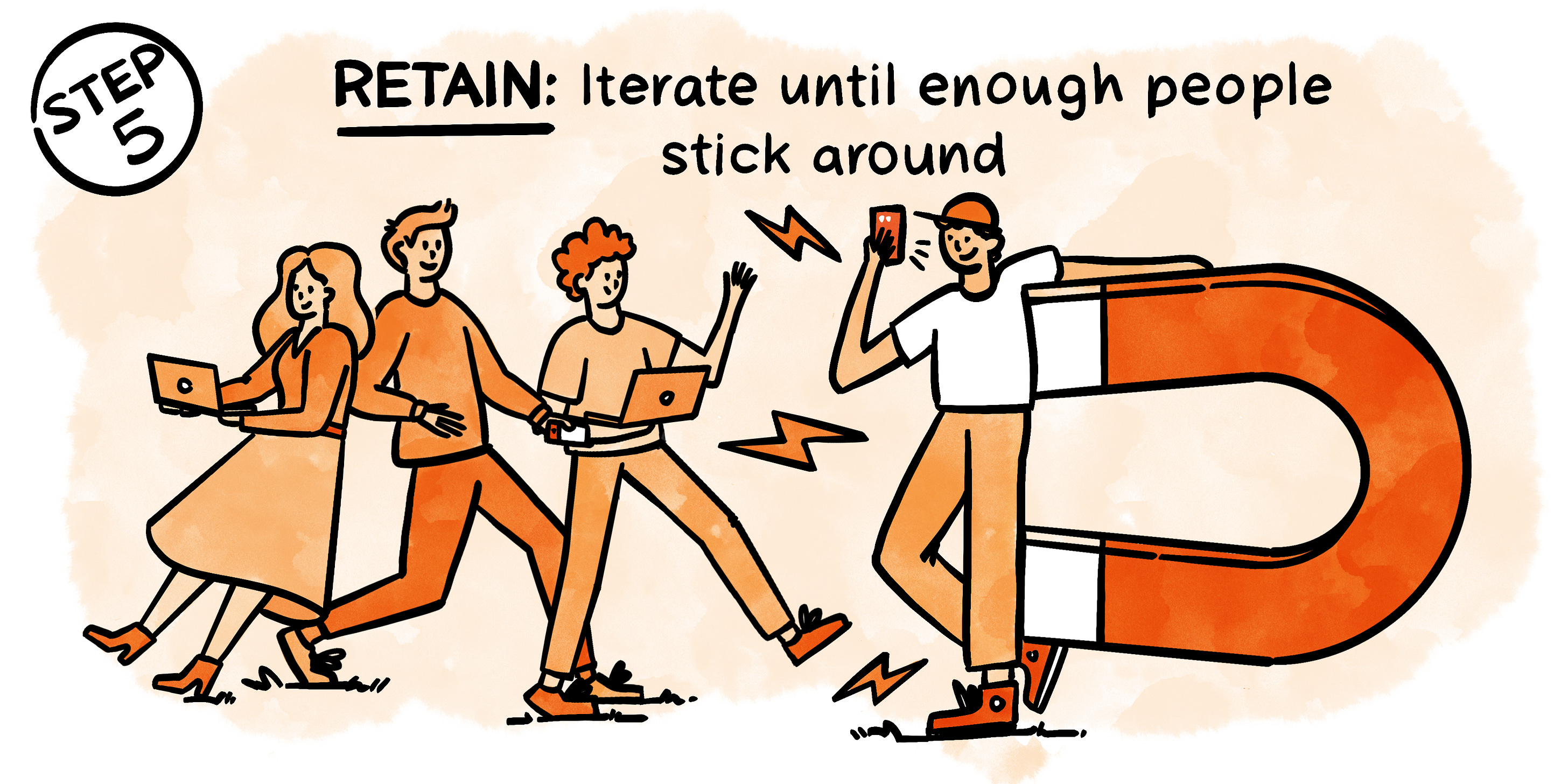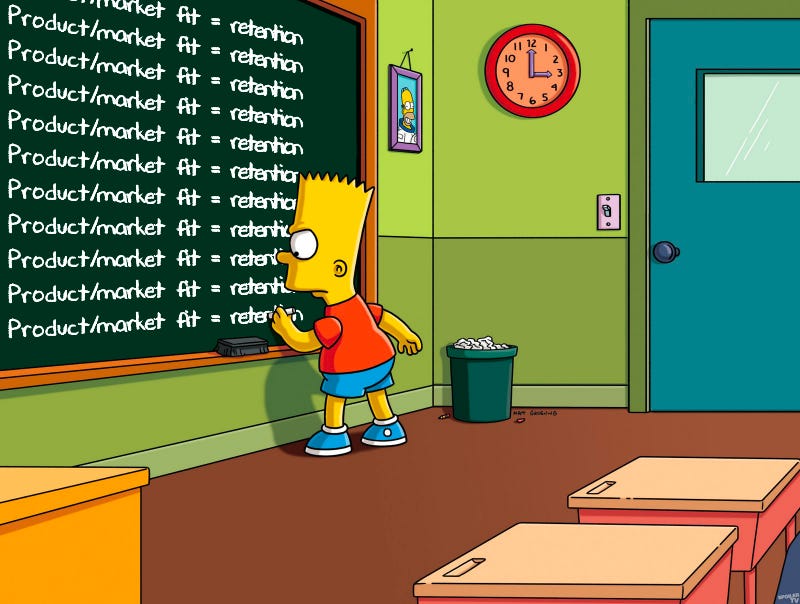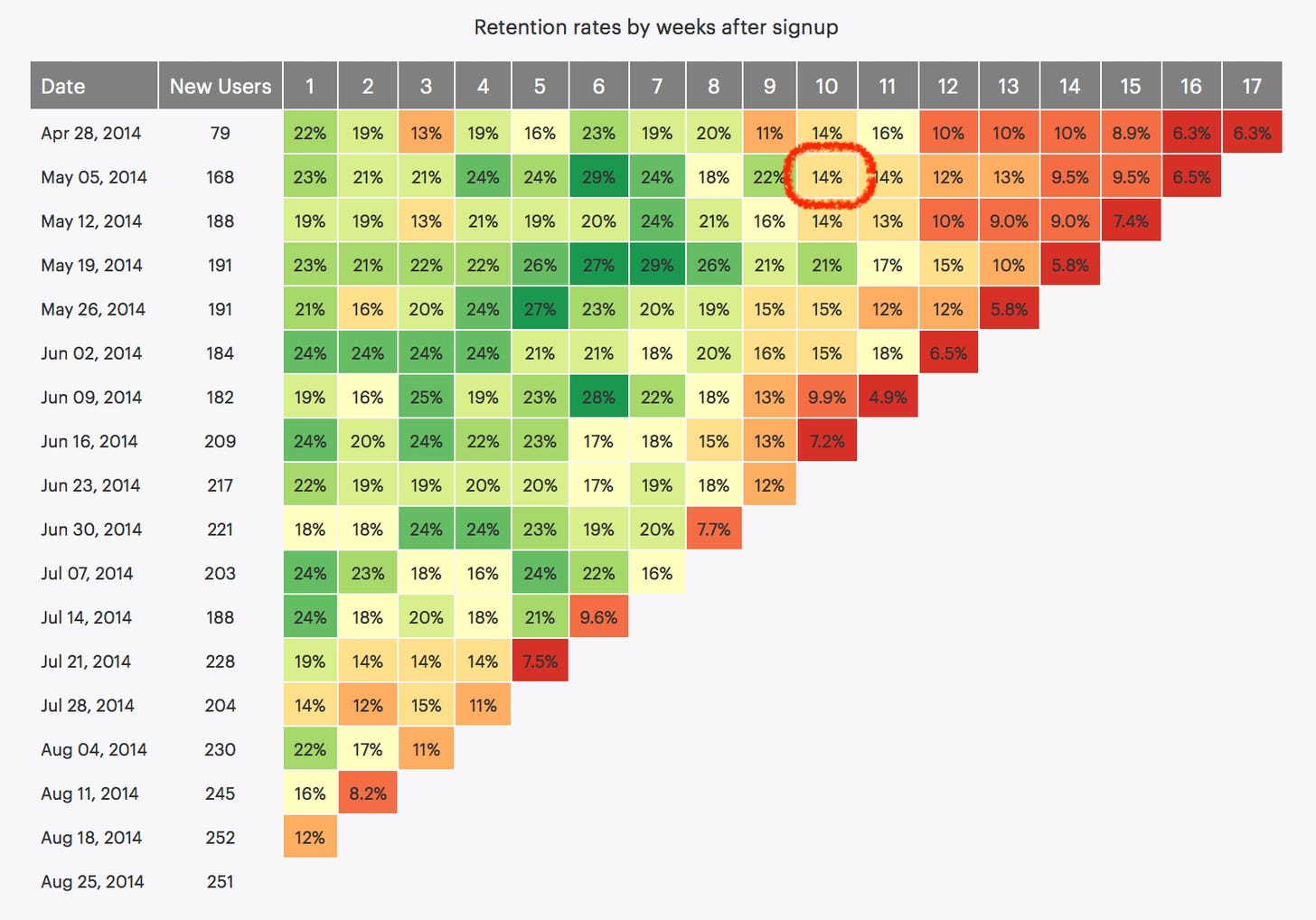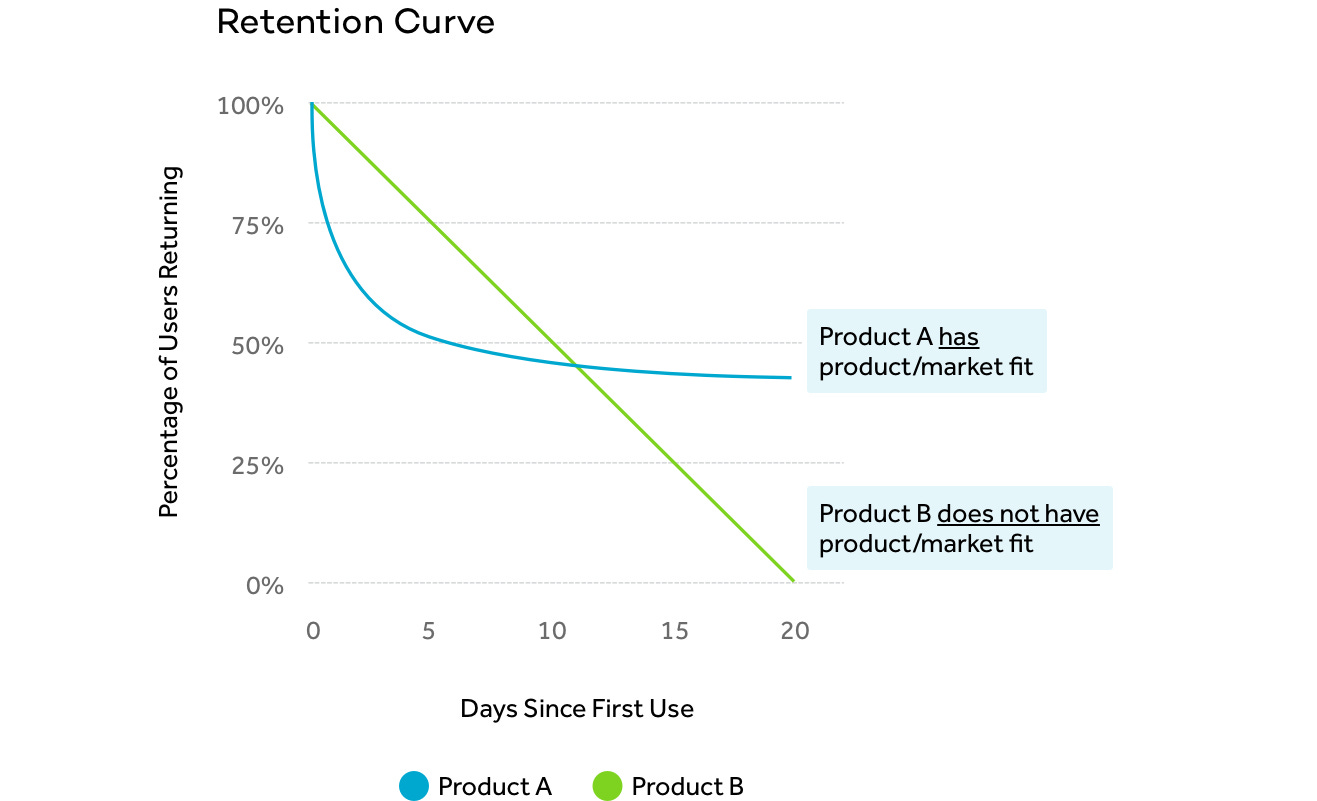How to kickstart and scale a consumer business—Step 5: RETAIN: Iterate until enough people stick around
Below is a peek at today’s subscriber-only post, part five of my six-part series on kickstarting and scaling a consumer marketplace. Subscribe today and get access to this issue—and every issue. How to kickstart and scale a consumer business—Step 5: RETAIN: Iterate until enough people stick aroundHow to know if you’ve got product-market fit, how to iterate toward product-market fit, and how long it usually takes👋 Hey, I’m Lenny and welcome to a 🔒 subscriber-only edition 🔒 of my weekly newsletter. Each week I tackle reader questions about product, growth, working with humans, and anything else that’s stressing you out about work. Send me your questions and in return I’ll humbly offer actionable real-talk advice. Welcome to part five (omg almost the end!) of our six-part series on kickstarting and scaling a consumer business. If you’re just joining us, here’s where we’re at:
By this point, you have a startup idea, a product, some early users, and you’re on a quest to find that elusive product-market fit. For this post, I researched the PMF journeys of dozens of today’s most successful consumer products and will help you understand:
Per usual, this post includes new concepts I’ve never before shared, a bunch of brand-new stories that I’ve gathered directly from founders, and few new frameworks. Again, a disclaimer: following these steps (or any steps) will not guarantee you success. But I am confident that it will significantly increase your odds. Big thank-you to Alyssa Ravasio (Hipcamp), Amir Nathoo (Outschool), Cem Kansu (Duolingo), Chris Best (Substack), Drew Houston (Dropbox), Evan Goldin (Lyft), Gagan Biyani (Udemy), Jonathan Badeen (Tinder), Kevin Systrom (Instagram), Kevin Tan (Snackpass), Marc Randolph (Netflix), Max Mullen (Instacart), Mike Evans (Grubhub), Rahul Vohra (Superhuman), Ryan Graves (Uber), Ryan Hoover (Product Hunt), Samuel Yam (Patreon), Sander Daniels (Thumbtack), Sarah Leary (Nextdoor), Steve Chen (YouTube), and Tommy Leep for contributing to this post, to Natalie for illustrations, and to Alex Ross (Greg app) and Hayley Barna (First Round Capital) for inspiring the PMF archetypes 🙏 Let’s get into it. Building something people want, and making money doing it at scale, is extraordinarily hard. Ninety percent of all startups fail, 75% of venture-backed startups don’t return cash to their investors, and the vast majority of startups run out of money before finding product-market fit.
I’m opening with these dire stats because (1) I want to discourage people who are scared by this from starting a company and, (2) if you can’t not start a company, to help you stay laser-focused on finding product-market fit. As venture capitalist Marc Andreessen put it:
How do I know if I have product-market fit?Below are four tell-tale signs that your product has product-market fit. However, it’s helpful to think of PMF not as a binary “you have it” and “you don’t have it” one-way-door kind of point, and instead as a spectrum of confidence that changes over time. On one end of the spectrum, you are 100% confident you have PMF. On the other, you definitely do not. The more signs of PMF you see, and the more intense each sign, the more confidence you should have that you’ve found, and still have, product-market fit. Here are the four clearest signs, in decreasing levels of confidence, that you have product-market fit: Sign #1 of PMF: Cohort retention curves flattenThere’s no better way to tell that people want your product than by people’s revealed preferences: using, and continuing to use, your product. In other words, retention.
There are a few ways to look at retention, but the most informative is to look at what’s called cohort-based retention: the percentage of users who continue to use your product x months/weeks/days later. You measure cohort retention by bucketing all the users who joined during a certain month/week/day (that’s your cohort) and looking at how many in this group are still active x months/weeks/days later. For example, if 100 users joined in January, and only 25 are still active in July, your six-month cohort retention is 25%. You can track this data either as a table: Or as a curve, which is often more interesting:
If this curve flattens above 0%, that means there is some part of the market that wants your product. Good work. However, to build a durable business, you’ll need this curve to flatten a lot higher. Based on my research, here’s what is considered good and great user retention at six months:
Read more about this here. And to measure cohort-based retention, you can use popular analytics tools like Amplitude, Mixpanel, Google Analytics, Mode, or you can find some plug-and-play templates here, here, or here. Note, it’s OK if your retention is lower than these benchmarks if:
Broadly, as Casey Winters wisely put it:
We’ll talk more about sustainable acquisition below. If you’re finding your retention metrics well below this, or don’t have enough data yet to know, keep reading. Sign #2 of PMF: Explosive growth through word of mouthMany of the smartest consumer minds out there consider exponential organic growth the sign you’ve hit PMF:
To make this even more real, here’s what the founders of some of today’s biggest consumer companies shared when I asked them what product-market fit felt like: Dropbox
Subscribe to Lenny's Newsletter to read the rest.Become a paying subscriber of Lenny's Newsletter to get access to this post and other subscriber-only content. A subscription gets you:
|
Older messages
Sign in to Lenny's Newsletter
Tuesday, August 9, 2022
. Here's a link to sign in to Lenny's Newsletter. This link can only be used once and expires after 24 hours. If expired, please try logging in again here Sign in now © 2022 2443 Fillmore St.,
How to launch and grow your product | Ryan Hoover of Product Hunt and Weekend Fund
Sunday, August 7, 2022
Listen now | Thousands of new products launch each year, but very few make it. Ryan Hoover has seen thousands of products launched over the course of his time running Product Hunt, and in this episode,
How to kickstart and scale a consumer business—Step 4: Find your early adopters by doing things that don’t scale
Tuesday, July 26, 2022
Also, how today's biggest consumer products got their first 1000 users
How to kickstart and scale a consumer business—Step 3: Craft your pitch
Tuesday, July 19, 2022
Lessons from Pinterest, Netflix, Tinder, Dropbox, DoorDash, Robinhood, Amazon, WhatsApp, and dozens of today's most successful consumer businesses
How to kickstart and scale a consumer business—Step 2: Identify your super-specific who
Tuesday, July 12, 2022
Lessons from Substack, Netflix, Yelp, Discord, TikTok, Instagram, Cameo, DoorDash, and dozens of others
You Might Also Like
🚀 Ready to scale? Apply now for the TinySeed SaaS Accelerator
Friday, February 14, 2025
What could $120K+ in funding do for your business?
📂 How to find a technical cofounder
Friday, February 14, 2025
If you're a marketer looking to become a founder, this newsletter is for you. Starting a startup alone is hard. Very hard. Even as someone who learned to code, I still believe that the
AI Impact Curves
Friday, February 14, 2025
Tomasz Tunguz Venture Capitalist If you were forwarded this newsletter, and you'd like to receive it in the future, subscribe here. AI Impact Curves What is the impact of AI across different
15 Silicon Valley Startups Raised $302 Million - Week of February 10, 2025
Friday, February 14, 2025
💕 AI's Power Couple 💰 How Stablecoins Could Drive the Dollar 🚚 USPS Halts China Inbound Packages for 12 Hours 💲 No One Knows How to Price AI Tools 💰 Blackrock & G42 on Financing AI
The Rewrite and Hybrid Favoritism 🤫
Friday, February 14, 2025
Dogs, Yay. Humans, Nay͏ ͏ ͏ ͏ ͏ ͏ ͏ ͏ ͏ ͏ ͏ ͏ ͏ ͏ ͏ ͏ ͏ ͏ ͏ ͏ ͏ ͏ ͏ ͏ ͏ ͏ ͏ ͏ ͏ ͏ ͏ ͏ ͏ ͏ ͏ ͏ ͏ ͏ ͏ ͏ ͏ ͏ ͏ ͏ ͏ ͏ ͏ ͏ ͏ ͏ ͏ ͏ ͏ ͏ ͏ ͏ ͏ ͏ ͏ ͏
🦄 AI product creation marketplace
Friday, February 14, 2025
Arcade is an AI-powered platform and marketplace that lets you design and create custom products, like jewelry.
Crazy week
Friday, February 14, 2025
Crazy week. ͏ ͏ ͏ ͏ ͏ ͏ ͏ ͏ ͏ ͏ ͏ ͏ ͏ ͏ ͏ ͏ ͏ ͏ ͏ ͏ ͏ ͏ ͏ ͏ ͏ ͏ ͏ ͏ ͏ ͏ ͏ ͏ ͏ ͏ ͏ ͏ ͏ ͏ ͏ ͏ ͏ ͏ ͏ ͏ ͏ ͏ ͏ ͏ ͏ ͏ ͏ ͏ ͏ ͏ ͏ ͏ ͏ ͏ ͏ ͏ ͏ ͏ ͏ ͏ ͏ ͏ ͏ ͏ ͏ ͏ ͏ ͏ ͏ ͏ ͏ ͏ ͏ ͏ ͏ ͏ ͏ ͏ ͏ ͏ ͏ ͏ ͏ ͏ ͏ ͏ ͏ ͏ ͏ ͏ ͏
join me: 6 trends shaping the AI landscape in 2025
Friday, February 14, 2025
this is tomorrow Hi there, Isabelle here, Senior Editor & Analyst at CB Insights. Tomorrow, I'll be breaking down the biggest shifts in AI – from the M&A surge to the deals fueling the
Six Startups to Watch
Friday, February 14, 2025
AI wrappers, DNA sequencing, fintech super-apps, and more. ͏ ͏ ͏ ͏ ͏ ͏ ͏ ͏ ͏ ͏ ͏ ͏ ͏ ͏ ͏ ͏ ͏ ͏ ͏ ͏ ͏ ͏ ͏ ͏ ͏ ͏ ͏ ͏ ͏ ͏ ͏ ͏ ͏ ͏ ͏ ͏ ͏ ͏ ͏ ͏ ͏ ͏ ͏ ͏ ͏ ͏ ͏ ͏ ͏ ͏ ͏ ͏ ͏ ͏ ͏ ͏ ͏ ͏ ͏ ͏ ͏ ͏ ͏ ͏ ͏ ͏ ͏ ͏ ͏ ͏ ͏
How Will AI-Native Games Work? Well, Now We Know.
Friday, February 14, 2025
A Deep Dive Into Simcluster ͏ ͏ ͏ ͏ ͏ ͏ ͏ ͏ ͏ ͏ ͏ ͏ ͏ ͏ ͏ ͏ ͏ ͏ ͏ ͏ ͏ ͏ ͏ ͏ ͏ ͏ ͏ ͏ ͏ ͏ ͏ ͏ ͏ ͏ ͏ ͏ ͏ ͏ ͏ ͏ ͏ ͏ ͏ ͏ ͏ ͏ ͏ ͏ ͏ ͏ ͏ ͏ ͏ ͏ ͏ ͏ ͏ ͏ ͏ ͏ ͏ ͏ ͏ ͏ ͏ ͏ ͏ ͏ ͏ ͏ ͏ ͏ ͏ ͏ ͏ ͏ ͏ ͏ ͏ ͏ ͏ ͏ ͏ ͏ ͏ ͏ ͏

